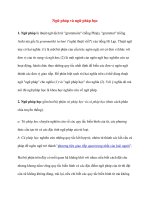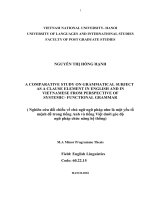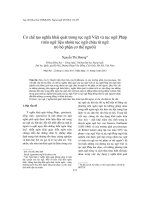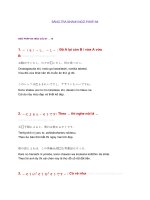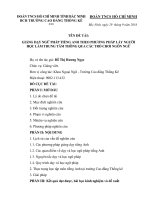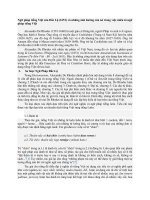NGỮ PHÁP VÀ BÀI TẬP THỰC HÀNH TIẾNG ANH 6 (SÁCH ILEARN ) (CÓ ĐÁP ÁN)
Bạn đang xem bản rút gọn của tài liệu. Xem và tải ngay bản đầy đủ của tài liệu tại đây (21.39 MB, 125 trang )
NGUYEN HOANG THANH LY
MINH LUAN
NGU
PHAP
VA BAI TAP THUC HANH
TIENG ANH 6
BAM SAT SGK CANH DIEU
i-learn Smart World
» _ Giải thích rõ ràng và chỉ tiết các điểm ngữ pháp
trọng tâm
» _ Các bài tập thực hành đa dạng được sắp xếp từ
dễ đến khó
e
Tài liệu hữu ích để chuẩn bị tốt hơn cho các bài
kiểm tra 15 phút và 1 tiết (45 phút)
NHÀ XUẤT BẢN ĐẠI HỌC QUỐC GIA HÀ NỘI
ae
| HỏNE
fara’
(NHÀ Ở)
A. NGU PHAP (GRAMMAR)
I. Thi hién tai don (Present simple tense)
Thi hién tại đơn diễn tả một thói quen hay một hành động lặp đi lặp lại ở
hiện tại, hoặc diễn tả chân lí và sự thật hiển nhiên.
Sau đây là cơng thức thì hiện tại đơn và các dấu hiệu nhận biết.
1. Với động từ be
a. Thể khẳng định (Positive form)
I+am
Tam =Tm
He/She/It + is
He is = He’s
We/You/They + are
She is = She’s
It is = It’s
We are = We're
You are = You're
They are = They’re
Vi DU:
Iam a
student.
(Tôi là một sinh viên.)
He is tall.
(Anh ay thi cao.)
They are adults.
(Họ là người lón.)
b. Thể phủ định (Negative form)
I+ am not
am not =’m not
He/She/It + is not
is not = isn’t
We/You/They + are not
are not = aren’t
vi DU:
I’m not a teacher.
(Tôi không phải là một giáo viên.)
(Chị ấy không e then.)
She isn’t shy,
(Chúng tôi không ở trong phòng.)
We aren’t in the room.
c. Thé nghi van (Question form)
Tra loi “Yes”:
Trả lời “No”:
Am +1?
Yes, [1+ am.
No, I+ am not.
Is + he/she/it ?
Yes, he/she/it + is.
No, he/she/it + isn’t.
Are + we/you/they ? | Yes, we/you/they + are.
No, we/you/they + aren’t.
vi DU:
Are you at home? - No, I’m not.
(Bạn đang ở nhà phải không? - Không, không phải.)
Is she tired? - Yes, she is.
(Cô ấy mệt hả? - Vâng, đúng vậy.)
2. Công thức với động †ừ thường
a. Thể khẳng định (Positive form)
I/We/You/They + V (nguyén thé)
He/She/It + V_s/es
vi DU:
I like this room.
He lives in the city.
(Tơi thích căn phịng này.)
(Anh ấy sống ở thành phố.)
* Quy tắc thêm s / es
es vào những động từ tận cùng là các chữ ch, sh, o, s, x, Z:
buzzes
watch > watches, wash > washes, go > goes, fax — faxes, buzz
- Thêm
s vào những động từ còn lại:
like > likes, swim — swims, run ~ runs
- Thêm
- Động từ tận cùng bằng chữ y có hai trường hợp:
Nếu trước y là một nguyên âm (u, e, o, a, 7) thì ta thêm ø:
play > plays
Nếu trước y là một phụ âm, ta đổi y — í rồi thêm es:
try > tries
- Các động từ không theo quy tắc:
have > has
b. Thể phủ định (Negative form)
UWe/You/They + do not + V (nguyên thể) | do not = don't
He/She/It + does not + V (nguyén thé)
does not = doesn’t
VÍ DỤ:
We don’t live in a dormitory.
(Chúng tôi không sống trong ký túc xá.)
He doesn’t know us.
(Anh ấy không biết chúng tôi.)
c. Thé nghi van (Question form)
Do + I/we/you/they + V (nguyên thể) ?
Does + he/she/it + V (nguyên thể) ?
Trả lời “Ves”:
Trả lời “No”:
Yes, I/we/you/they + do.
No, I/we/you/they + don’t.
Yes, he/she/it + does.
No, he/she/it + doesn’t.
vi DU:
Do they often go shopping? - Yes, they do.
(Họ có thường đi mua sắm khơng? - Vâng, có.)
Does she like swimming? - No, she doesn’t.
(Cơ ấy có thích bơi khơng? - Nhơng, cơ ấy khơng thích.)
3. Dau hiệu nhộn biết
Trong câu dùng thì hiện tại đơn thường có các từ để nhận biết như:
- always (ln ln), usually (thường xuyên), often (thương thường, thường lệ),
frequently (thudng xuyén), sometimes (thỉnh thoảng, đôi khi, đôi lúc), seldom
(it khi), rarely (hiếm khi), never (khơng bao giờ).
VÍ DỤ:
We usually do morning exercise.
(Chúng tôi thường tập thể dục buổi sáng.)
- every day, every week, every month, every year.. (mdi ngay, méi tuan,
mỗi tháng, mỗi năm...)
VÍ DỤ:
I get up early every day.
(Tôi thức dậy sớm mỗi ngày.)
once/twice/three times/four times... (m6t lan/hai lan/ba lần/bốn Ian...) a day!
week/month/year...
(một ngày/tuần/tháng/năm)
VÍ DỤ:
She goes to the park twice a week.
(Cô ấy đến công viên hai lần một tuần.)
~n the morning (vào buổi sáng), in spring.. (vào mùa xuân...)
VÍ DỤ:
It’s cold in winter.
- on Mondays,
weekdays, weekends
tuần, các ngày cuối tuần)
(Trời thì lạnh vào mùa
đơng.)
(vào các ngày thứ Hai, các ngày trong
VÍ DỤ:
We have Science on Tuesdays.
(Chúng tơi có mơn Khoa học vào các ngày thứ Ba.)
II. Thì hiện tại đơn với câu hỏi Có / Khơng (Presenf simple with Yes /
No questions)
Những câu hỏi cần câu trả lời Có (Yes) hoặc Khơng (No) được gọi là câu hỏi
Có / Khơng
(Yes / No Questions)
VÍ DỤ:
Do you live in an apartment?
(Bạn sống trong căn hộ phải không?)
Trả lời là có hay khơng:
Yes, I do. / No, I don’t.
(Vang, đúng vậy. / Không, không phải.)
1. Công
thức
auxiliary verb (be, do...) + subject + verb
vi DU:
Be:
Is the yard large?
(Sân có rộng khơng?)
Does it have a balcony?
(Nó có ban cơng khơng?)
Do:
2. Câu hỏi phú định
(Negative yes-no questions)
Chúng ta thường sử dụng các câu hỏi phủ định có - khơng để kiểm tra hoặc
xác nhận
điều gì đó mà chúng
ta tin tưởng hoặc mong
đợi là đúng,
hoặc khi
chúng ta cho rằng điểu gì đó là điều tốt nhất nên làm. Chúng ta thường sử dụng
dang viét tat cua NOT 1a n’t.
Vi DU:
Isn’t that their apartment?
(Đó chẳng phải là căn hộ của họ a?)
Ỏ ví dụ này thì người hỏi khá chắc chắn “đó là căn hộ của họ” và chỉ hỏi để
nghe sự xác nhận từ người được hỏi.
Ill. Thì hiện tại đơn với câu hỏi dùng tir héi wh (Present simple with Whquestions)
Khi chúng ta cần hỏi thơng tin rõ ràng và có câu trả lời cụ thể về người, vật,
sự việc, hay hiện tượng nào đó ta dùng câu hỏi với các từ để hỏi. Các từ để hỏi
này có điểm chung là chữ wh. Vì vậy câu hỏi dùng với các từ để hỏi này cịn gọi
là wh-questions.
1. Cơng thức
a. Với động từ thường:
Question word + auxiliary + subject + verb...?
Vi DU:
Where do you live?
(Bạn sống ở đâu?)
b. Với động từ be:
Question word + be + subject...?
VÍ DỤ:
What is your address?
(Dia chỉ của bạn là gì?)
2. Cac từ hỏi (Question words)
Từ để hỏi wh-qguestion words còn được gọi là các đại từ nghỉ vấn, bao gồm
các từ thông dụng sau.
a. Who (ai): Dùng để hỏi về người.
VÍ DỤ:
Who is she?
(Cơ ấy là a1?)
Who do you like?
(Ban thich ai?)
b. Whose (cua ai): Dung để hỏi về chủ sở hữu.
VÍ DỤ:
Whose bag is this?
(Đây là túi xách của ai?)
Whose are these books?
(Những quyển sách này là của ai?)
c. Where (ở đâu): Dùng để hỏi vị trí và địa điểm.
VÍ DỤ:
Where is the bathroom?
(Phịng tắm ở đâu?)
Where do you come from?
(Bạn đến từ đâu?)
d. When (khi nào): Dùng để hỏi về thời gian.
VÍ DỤ:
When is your birthday?
(Sinh nhat cua ban khi nao?)
When does the first bus leave?
(Khi nào chuyến xe buýt đầu tiên khỏi hành?)
e. Why (tại sao): Dùng để hỏi ngun nhân và tìm lí do.
VÍ DỤ:
Why is he always punctual?
(Tạo sao bạn ấy ln đúng giị?)
Why do I often have bad marks?
(Tại sao tôi thường bị điểm thấp?)
£. What (vật gì, cái gì): Dùng để hỏi về sự việc hay điều chưa biết.
VÍ DỤ:
10
What is this?
(Đây là cái gì?)
What do you want?
(Bạn muốn gì?)
ø. Which (người nào, vật nào): Dùng để hỏi về sự lựa chọn.
VÍ DỤ:
Which 1s the correct way to school?
(Đường nào là con đường đúng để đến trường?)
Which room do you like more, bedroom or living room?
(Bạn thích phịng nào hơn, phòng ngủ hay phòng khách?)
h. How (như thế nào, bằng cách nào): Dùng để hỏi cách thức, tình trạng.
VÍ DỤ:
How is your home?
(Nhà của bạn thế nào?)
How do spell this word?
(Bạn đánh vần chữ này như thế nào?)
IV. Sở hữu cách (Posifive case)
1. Định nghĩa
Sở hữu cách được dùng để diễn tả sự sở hữu của đối tượng thứ nhất với đối
tượng theo sau bằng cách thêm 's vào sau đối tượng thứ nhất.
VÍ DỤ:
Michael’s house
2. Cách
(Nhà của Michaels)
dùng
- Dùng để diễn đạt sự sở hữu của người và vật.
VÍ DỤ:
Paulie’s room is small.
(Phong cua Paulie nho.)
- Dùng để diễn đạt thời gian.
VÍ DỤ:
a month’s time
(thời gian một tháng)
- Dùng để chỉ sự sở hữu cách với những vật duy nhất.
VÍ DỤ:
the Earth’s orbit
(quỹ đạo của Trái đất)
- Khơng dùng sở hữu cách với sự vật, sự việc và hiện tượng mà thay vào đó
ta dùng giới từ ‘of.
11
vi DU:
the lid of the pot
(cái nắp của cái nồi)
3. Ký hiệu sở hữu cách
- Thêm
's vào sau danh
từ số ít, không
nhưng không kết thúc bằng %*
đếm
được hoặc danh
từ số nhiều
VÍ DỤ:
Mr. Ben’s apartment isn’t cheap.
(Căn hộ của ơng Ben thì khơng rẻ.)
Their children’s bedrooms are big.
(Phịng ngủ của các con họ thì lồn.)
- Chỉ thêm dấu lược “ vào sau danh từ số nhiều hoặc từ tận cùng là “s.
VÍ DỤ:
My grandparents’ house is in the suburb.
(Nhà của ơng bà tơi thì ở ngoại ơ.)
B. BÀI TẬP (EXERCISES)
Chọn phương án đúng theo thì hiện tại đơn. (Choose the correct option in the present simple.)
dạ
We (have / has) a new house.
2
(Does / Do) it have a balcony?
3.
My cousins (aren’t / isn’t) in grade 6A.
eM
AS
ow
4 . Their house (isn’t / be not) large.
Betty and Daisy (don’t live / doesn’t live) near here.
Alexander (go / goes) to the church every Sunday.
My parents often (gets up / get up) early.
(They are / Are they) very good at Math?
She usually (watch / watches) TV in the living room.
10. The cat (is / am) in the front yard.
12
II.
Chia
động
verbs
từ theo
thì hiện
1.
They
2.
I
3.
She
4.
Our house
form
of the
(live) with her parents in town.
(not have) a back yard.
(you, like) our little garden?
This living room
7.
John
8.
Town houses
9.
Your bedroom
(not be) big but beautiful.
(often take) a bus to school.
(be) usually expensive.
(look) really nice.
10. They
phương
(not own) any apartment in the city.
án đúng
theo câu hỏi Có / Khéng.
option for Yes /No questions.)
1.
Does your room (have / has) a window?
2.
(Be/Is) your father a teacher?
3 .
(Do you have/ Have you) any question?
4.
(They are / Are
(Choose
the correct
they) kind and friendly?
ol
ˆ
the correct
(be) hungry and tired now.
6.
Chon
(Supply
(have) a house in the suburb.
5.
Ill.
tại đơn.
in the present simple.)
(Do / Does) she tell you my name?
6.
(Live you/ Do you live) near our school?
7.
(Isn’t / Is not) it your grandparents’ apartment?
8.
(Don’t you know / Do you not know) the regulations?
9.
(Am Inot/ Am
J) too noisy and talkative?
10. (Does it look not / Doesn't it look) like the way to your home?
IV.
Viết câu hỏi Có/ Khơng cho các cau sau. (Write Yes / No questions for
the following statements.)
1.
His house is on the side of a hill.
2.
The dog jumps at the kitchen.
13
It isn’t a good place.
They live on this side of the road.
©t
Tm right about your exams.
You aren’t so happy about the result.
¬
Their flat doesn’t have a balcony.
The foundations of the house aren’t stable.
Your father is on a business trip.
1 0. She doesn’t go home in the dark.
V.
Chon phuong an dung. (Choose the correct option.)
1.
(Who / When / Why) is the monitor of the class?
(Where
/ What
/ Which)
is the weather like?
(Whose / Who / What) bicycle is this?
(Who / Where / Why) do you like English?
5_
(What / When / Where) is the bank, please?
6.
(Who / What / Which) is the girl in brown pullover?
Ts
(Which / How / What) do you go to school?
8.
(What / How / Which) is your house, this one or that one?
9.
(Who / When / Where) does the bus arrive at the station?
1 0. (Why / What / Who) are you angry with me?
14
VI.
Chon dap an ding. (Choose the correct answer.)
1.
is the woman in rose dress? - She’s my mother
A. Which
2.
B. Who
C. How
D. Whose
do we get there? - It’s about noon.
A. Where
3.
B. Why
C. When
D. How
house is that? - It’s the Browns’.
A. Whose
4,
B. How
C. Where
D. Where
does your daddy look like? - He’s tall.
A. How
5.
B. Whose
C. Which
D. What
is the correct way, the left or the right? - The left.
A. Which
6.
B. How
C. Where
D. Why
is the bathroom? - It’s behind the bedroom.
A. What
hs
B. Where
C. Whose
D. Which
do you like this neighborhood? - Very much.
A. Who
B. Which
C. When
D. How
do you often close the windows? - Because I’m cold.
8.
A. Where
9.
B. What
C. Why
D. When
keys are on the dining table? - They are mine.
A. Which
10.
B. Whose
C. What
D. Where
do I get to the shoes store? - Follow this way.
A. Why
B. When
C. Where
D. How
VII. Điền vào chỗ trống tu hdi thich hgp nhat. (Fill in the gap with the most
suitable question
word.)
1.
do you come from? - Binh Duong Province.
2.
type of house does he prefer, apartment or town house?
3.
does the game show on TV start? - At 7.30 p.m.
4,
is your address? - It’s 7 Hung Vuong street.
15
bike is this? - Maybe it belongs to Jack.
5.
do you want to meet? - Mr. Dawson.
6
is the central post office, please? - At the end of this street.
7
does your mother go to the market? - By bike.
8.
is your puppy’s name? - It’s Ben.
9
is that man over there? - That’s my brother.
10.
VIII. Điền vào chỗ trống dạng đúng của sở hữu cách. (Fill the gaps with the
correct form of possessive case)
BEDROOM
THISIS
ViDU:
—>
Jenny’s
1. That is
office. (Mr. White)
2. They visit the
3. This is
. (Johns)
reading room. (my family)
brother is eleven years old. (Tommy)
4.
house. (Mr. and Mrs. Collin)
5. Our house is smaller than
clothes aren’t usually colorful. (Men)
6
country house isn’t near here. (grandparents)
7. My
house doesn’t have a basement.
8
9. Those are my
10. That is our
IX.
(Davis)
cars. (neighbors)
meeting room. (teachers)
Hoàn thành câu với dạng đúng của sở hữu cách hoặc dùng giới từ “of.
(Complete the sentences
using ‘of’.)
THE APARTMENT
vi DU:
with the correct form of possessive case or
HAS AN
It’s the
> elevator of the apartment
1.
The house has an attic.
It’s the
2.
Mr. Lucas has a villa.
It’s
16
(JENNY).
ELEVATOR.
. Daisy has a kitty.
It’s
. My parents live in this flat.
It's
. There is coffee in the cup.
It’s the
. The vase has a handle.
This is the
. My cousin has a bike.
It's
. Emily has a
sister, Bella.
Bella is
. The trip takes an hour.
It’s
10. The house has a door.
This is the
17
eee
he
|
>
SCHOOL
(TRƯỜNG HỌC)
2
UNIT
rs
A. NGỮ PHÁP (GRAMMAR)
I. Liên từ (Conjunctions)
Liên từ là từ dùng
để nối các từ hoặc cụm từ cùng một loại, hoặc những
mệnh để ngang hàng nhau. Tiếng Anh có nhiều liên từ nhưng có một số từ
thơng dụng sau.
1. And (và)
Dùng để thêm thơng tin vào câu nói.
VÍ DỤ:
I like Music and Arts.
(Tơi thích Âm nhạc và Mỹ thuật.)
John is my classmate, and he is a good student.
(John là bạn cùng lóp của tơi và bạn ấy là một học sinh giỏi.)
2. Or (hoặc, hoặc là)
Dùng để diễn tả sự lựa chọn.
VÍ DỤ:
I don’t like Math or Physics.
(Tơi khơng thích mơn Tốn hoặc mơn
Vật lý.)
He plays sports or plays the guitar in free time.
(Anh ấy chơi thể thao hoặc chơi dan ghi ta khi rảnh rỗi.)
3. But (nhưng)
Dùng để nêu lên hai thông tin đối ngược nhau.
18
vi DU:
Jack usually gets up late, but he never comes to school late.
(Jack thường thức dậy muộn nhưng anh ấy không bao giờ đến trường trễ.)
4. So (nên, cho nên, vì vậy)
Dùng để chỉ kết quả, hệ quả.
VÍ DỤ:
Jenny studies hard, so she often gets good marks.
(Jenny cham học nên cô ấy thường đạt điểm tốt.)
Il. Tinh từ sở hữu và dai tiv sé hitu (Possessive adjectives and Possessive
pronouns)
- Tính từ sở hữu đứng trước một danh từ trong khi đại từ sở hữu có thể làm
chủ ngữ (đứng đầu câu) hoặc làm tân ngữ (đứng cuối câu).
VÍ DỤ:
This pen is blue. It’s your pen.
(Cây viết này màu xanh. Nó là cây viết của bạn.)
This pen is yours.
(Cây viết này là của bạn.)
Mine is black.
(Cái của tôi màu đen.)
The black pen is mine.
(Cây viết màu đen là của tôi.)
- Đại từ sở hữu được dùng để thay cho một cụm từ.
VÍ DỤ:
That is your book.
(Đó là sách của bạn.)
That is yours.
(Đó là của ban.)
— “yours” thay cho “your book”
Các tính từ sở hữu và đại từ sở hữu tương ứng với các đại từ nhân xưng
trong bảng sau.
Personal pronoun
Possessive adjective
Possessive pronoun
I
my
mine
we
you
they
he
she
it
our
your
their
his
her
its
ours
yours
theirs
his
hers
its
19
Ill. Cac động từ chỉ sự yêu thích (Verbs of liking)
- Các động từ chỉ sự yêu thích gồm các từ phổ biến như: adore đất thích),
enjoy (thưởng thức,
thích thú), detest (căm ghét), dislike (khơng thích), fancy
(thích), hate (ghét), like (thích), love (yêu)... Trong d6, adore, enjoy, detest, fancy
chỉ được theo sau bởi dạng động từ thêm -ing (verb-ing). Các động từ còn lại
được
theo sau bởi dạng verb-ing hoặc dạng động từ ngun mẫu
có £o đứng
trước (o-infinive).
VÍ DỤ:
They like playing shuttlecock in break time.
(Ho thich choi da cau trong gid nghi.)
They like to play shuttlecock in break time.
(Ho thich chai da cau trong gid nghi.)
We enjoy hanging out with friends.
(Chúng tơi thích tụ tập với bạn bè.)
B. BÀI TẬP (EXERCISES)
I. Chọn phương án đúng. (Choose the correct option.)
©
œ mm
Øœ ƠI
Fw nN
1.
(Our/ Ours) class is going on a picnic tomorrow.
Is that (your/ my) bike? - Yes, it is mine.
It’s our house. It’s not (their / theirs).
Her schoolbag is white. (Your / Yours) is black.
This is (our / ours) classroom. Their room is over there.
Is this Hoang’s notebook? - Yes, it’s (his / him).
This book is interesting, and (it / its) cover is nice too.
Whose chair is this? - Is it (his / your)?
Is this beautiful pencil case his or (her / hers)?
10. Those are her clothes. They are not (hers / mine).
II.
Dién vao chỗ trống với một tính từ hoặc đại từ sở hữu thích hợp. Dùng
đại từ trong ngoặc làm gợi ý. (FilI in the gaps with a suitable possessive
adjective or positive pronoun.
20
Use pronouns in the brackets as a cue.)
1.
Your room is twice the size of
2.
My cat is very cute.
.()
name is Mio. (It)
Our football team will defeat
this time. (They)
I don’t know what to do. The decision is
She is smart because
(She)
oc
oN
We sometimes visit
. (You)
parents are brilliant scientists.
friends in the suburbs. (We)
He wants to swap my ruler for
. (He)
It is interesting to compare their marks and
Sally and Bob are friends.
(They)
. (We)
school is near my house.
10. There’re some differences between his exercises and
(She)
© œ xì œ ƠI
fo
BS ra
Ill. Chon phuong an dung. (Choose the correct option.)
It was Sunday, (or/ so) she could get up late.
Lopez is a beautiful (and / but) attractive actress.
Is this a figure of three (or / and) an eight?
There’s a parcel (or / and) some letters for you.
She grows up in London (so / but) she knows it well.
Iam bad at English, (but / or) he is worse than me.
He was late (or / and) the teacher was furious with him.
Our teacher is strict, (so / or) we have to do what he says.
Jim was angry with Janes, (so/ but) they are friends again now.
10. Would you like some candies, (but / or) some biscuits?
Dién vao ché tréng and, or, but hoac so. (Fill in the gaps with and, or,
but, or so.)
1.
Td like a hamburger
an iced tea.
2.
The cat is hungry,
3.
I like Harry,
4.
Which has spots, the leopard
5.
I don’t know. He may come
6.
My twin brother
I have the same nose.
7.
It is dark inside,
he pulled the curtains.
I feed it.
I don’t dare to say so.
the tiger?
he may not.
21
8. It is going to rai
we still want to go home.
n, =——————
you will be happy.
9. Love one another
we might get lost.
10. We should stay together,
V.
ng từ bên dưới ở dạng verb-ing.
Hoàn thành các câu sử dụng độ
verb-ing form of the verbs below.)
(Complete the sentences using
read
sing
travel
1.
Ms Lien adores
2.
Inever enjoys
3.
She fancies
4.
He hates
talk
5 . She loves
6.
Those girls don’t like
ih
My mother prefers
8.
He likes
9.
She detests
10. I dislikes
go
work
wait
be
watch
drink
with children.
comics.
game shows on TV.
about his mistakes.
karaoke with friends.
out after dark.
coffee in the morning.
alone in the house.
at the checkout.
by train.
dựa vào c ác tii gai y. (Write complete
VỊ. Viết câu dùng cấu trúc Verb-ing
sentences
using Verb-ing and the prompts.)
vi DU:
ginger.
1/1ike / drink / hot water / some
ginger.
[like drinking hot water with some
4
22
1.
1/ hate / take / shower / winter.
2.
Adults / not / like / eat / candies.
3.
ther.
1/ not / fancy / fish / the cold wea
4.
badminton.
My sister and I/ adore / play /
5.
I/really love/ read / bed / night.
6.
He/ dislike / wash / dishes.
7.
I/not/like / get up / early / Sundays.
8.
He/enjoy/ go to/ cinema.
9.
They /not/like/ go to / doctor.
10. She / not / like / clean / house.
23
(UNIT 1 + UNIT 2)
Il.
Chia d6ng tu theo thi hién tai don. (Supply the correct form of the verb
in the present simple.)
1.
She
2.
We
(be) at the ice cream stand.
3.
He
(get) a lot of letters.
4
(you, have) some free time?
5.
It
6.
I
II.
(not, want) to go.
The houses around here
9. We
10.
(be) an old building.
(she, live) in a town house?
1.
8.
(go) to school by bicycle.
(not, go) to school on Saturdays.
(not, be, it) cold today?
Viết câu hỏi Có / Khơng cho cac cau sau. (Write Yes
/ No questions for
the following statements.)
24
(be) very old.
1.
You are very helpful.
2.
She is as graceful as a swan.
3.
They don’t have enough books.
4.
It’s a very beautiful place.
5.
He walks really slowly.
He is an excellent goalkeeper.
She eats lots of fruit.
They teach painting at your school.
Those apartments aren’t expensive.
10. He knows English.
Ill. Chon
dap an dung.
(Choose the correct answer.)
notebook do you like better? - This one.
1.
A. Which
B. Who
C. How
D. Whose
fault is that? - It’s not my fault.
A. Who
B. Whose
C. Which
D. What
does no one laugh at my joke? - Because it’s not funny.
A. What
B. How
C. When
do you know?’
he
. ‘There’s no one in the class.’ - ‘
A. How
B. Why
D. Why
C. Who
D. What
are you going for your holidays? - Da Lat.
A. Who
- At 7.30.
A. What
B. How
C. Where
does the next bus to Ben Thanh Market leave?
B. Where
C. When
is the height of the board?
A. Which
D. When
B. What
C. Why
- About
D. Which
2,5 meters.
D. How
is the headmaster of this school? - Mr. Allen.
A. How
B. When
C. Who
D. Where
25
9.
do I get to the shoes store? - You can walk.
A. What
B. Whose
10.
D.
How
city is larger, Can Tho or Da Nang?
A. Which
IV.
C. Where
B. Why
C. Where
D. How
Hoàn thành câu với dạng đúng của sở hữu cách hoặc dùng giới từ “of.
(Complete the sentences
with the correct form of possessive case or
using ‘of’.)
1.
The kid has a toy.
— It’s the
2.
Philip has a bike.
= It’s
8.
Our classmates live in this apartment.
= It’s
4.
There is water in the glass.
—Itsa
5.
This car has a name.
— What is the
6.
2
The trip lasts two hours.
> Itsa
7.
Johnson has a brother, Jimmy.
> Jimmy is
8.
The building has a name, “Anna Tower”.
— “Anna Tower” is the
9.
This dormitory is for girls only.
— It’s the
10. The workbook has my picture on its cover.
— My picture is on the
V. Chon
26
phuong
an dung.
(Choose the correct option.)
1.
She has a cat. That cat is (her / hers).
2.
He has a
key. That key is (his / his’).
&
@v ce
oO
William has a dog and (its / it) name is Becky.
Is she a friend of (your / yours)?
Loan has a bicycle. (Her / Hers) bicycle is red.
Five students don’t finish (their / theirs) maths exam.
Thave a bike. That bike is (my / mine).
We have a flat. That flat is (our / ours).
I want to go to Paris and see (it / its) monuments.
10. Jennifer goes to school with (her / hers) sister.
VI. Điển vào chỗ trống and, or, but hoặc sơ. (Fill in the gaps with and, or,
but, or so.)
I don’t say much.
1.
I think a lot,
2.
Justine
3.
Is it a boy
4.
It’s an old car,
5.
I’m late,
6.
He hasn’t got a car,
7.
She grows up in London,
8.
Which do you prefer, the town
9.
They invite us to the party,
busy.
I got admission at the same time.
a girl?
it’s very reliable.
my friends are angry with me.
he goes to work by bus.
she knows it well.
the country?
we refuse because we are
I clean our room on alternate days.
10. He
VII. Hoàn thành câu sử dụng động từ bên dưới ở dạng verb-ing. (Complete
the sentences
start
walk
form of the verbs below.)
using verb-ing
play
join
1.
He loves
2.
She doesn’t like
3.
She fancied
4.
He detests
5.
The children enjoyed
6.
She hates
drive
do
hide
celebrate
ask
lend |
table tennis.
her books.
her birthday with lots of friends.
the day with an argument.
in the bushes.
the same work day after day.
27
7.
We enjoy
8.
She adores
9.
He dislike
in the mountains.
the volleyball team.
his parents for help.
10. They don’t like
in rush hours.
Vill. Chon dap an dung. (Choose the correct answer.)
1.
My cycle is broken,
A. or
I shall have to walk.
B. but
C. and
D.
so
C. mine
D.
me
Your room is larger than
A.I
B. my
Look there!
are they? They’re my neighbours.
A. Who
B. Where
She usually
C. Which
D.
What
D.
to sing
D.
Willy’s
in the shower.
A. sing
B. sings
C. singing
. Whose books are these? - They are
A. my
B. their
.
C. her
We have a curtain for living room,
curtain for the bedroom.
A. or
B. and
we
C. but
don't have
D.
a
so
do you want to meet? - In front of the cinema.
A. Which
B. Where
We want a house like
A. they
B. their
People love this city,
A. and
10.
D. Why
.
C. theirs
D. theirs’
they will make it a better place.
B. so
C. or
D. but
way is quicker, by bus or by train?
A. When
28
C. Whose
B. What
C. How
D. Which

